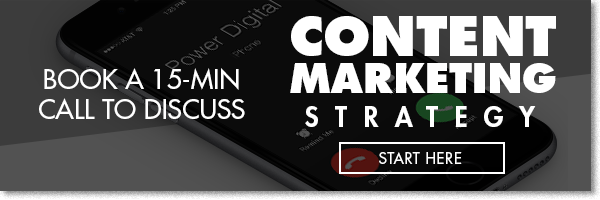Content Marketing for B2B
Every buyer you encounter follows an important journey as they work through their decision to purchase your product or service. The simple truth is that modern buyers don’t want to simply be prospected, demoed, or closed using old-school sales techniques. These archaic approaches add absolutely no value to the buyers of today and may actually turn many of them away from your products or services.
Related: What is B2B Marketing?
Modern buyers want to be able to find most of their information about your offerings online initially, and when they do contact you as the seller, they want to receive additional information that they haven’t already found for themselves that directly addresses their individual requirements. It is essential for today’s companies to personalize their sales process to fit the modern buyer’s needs at every stage of their journey.
Understanding the Buyer’s Journey
Meeting the buyer’s needs today begins with understanding the complete buyer’s journey, the entire process that each individual buyer goes through as they become aware of, take time to evaluate, and then finally decide to purchase a new product or service. This journey involves a detailed three-step progression.
Awareness
The first stage of the buyer’s journey begins when a prospective buyer realizes that they have a need or problem that can be solved by making a purchase. During the Awareness Stage, potential buyers recognize their challenge or requirement as presenting them with an opportunity for growth or improvement that they want to follow. This is when they decide whether or not this particular goal or need is a true a priority for them. It is essential to fully understand this stage for your buyers in order to make your product or service appealing to them. You should be able to clearly identify:
- How your buyers would think of and define their specific goals, needs, or problems.
- What common misconceptions your buyers might have about addressing these goals, needs, or problems.
- How your buyers generally proceed to educate themselves about these specific goals, needs, or problems.
- What the consequences of inaction on their part may be for your buyers, and what will motivate them to take action.
- How your buyers generally decide whether or not their goal, need, or problem should be a priority for them.
This first stage of the buyer’s journey provides you with your first opportunity to connect with potential buyers. Having these elements in mind will help you tailor that first interaction to be a positive, helpful moment.
Related: Why Awareness Is an Important Step in the Buyer’s Journey
Consideration
This second stage of the buyer’s journey begins once your prospective buyers have clearly defined their goal, problem, or need and have decided that addressing it is indeed a priority for them. They now begin to consider different possible approaches or ways in which they can pursue their specific goal, meet their need, or solve their problem. During the Consideration Stage, your buyers actually commit to meeting this requirement, whatever it might be, and begin to evaluate these different ways in which they can address their specific goal, need, or problem. To properly meet their demands during this stage, you need to be certain that you understand:
- What categories of solutions your buyers generally take the time to research and consider to meet this specific goal, need, or problem.
- How your buyers usually learn about the various options that will meet their requirements.
- How your buyers tend to distinguish the pros and cons for each option available.
- How your buyers will ultimately decide which solution is the right one for them.
This last element leads them to the final phase of the buyer’s journey and providing them with relevant, helpful information at this time further cements your relationship with them as they move into the decision-making phase.
Decision
During the Decision Stage, your buyers have already decided on the type of solution they are interested in purchasing. Now they are ready to decide on the specific product or service that will best fit their requirements. To do this, they may create a list of pros and cons, conduct extensive research, and/or consult with other companies about the solutions they have used successfully to address the same needs. Elements that you need to consider during this stage of the buyer’s journey include:
- What specific criteria your buyers may use to evaluate and differentiate between the available offerings.
- What your buyers like about your company’s offering(s) when compared to your competitors.
- What concerns your buyers may have about your offering(s) including pricing and implementation strategies.
- Which people in your buyers’ organizations need to be involved in the final decision-making process.
- How perspectives may differ for each person in their organization who is involved in making the final buying decision.
- Whether or not your buyers expect to be able to try out your offering for free before purchasing it.
- Whether your buyers need to make any additional preparations before deciding on or actually purchasing your product or service.
Mastering all of the elements in each of these three stages will help you to fully understand your buyers’ journey so that you can properly address each stage through all of your sales and marketing efforts.
Content is Essential for Each Stage of the Buyer’s Journey
In order to meet the needs of your potential buyers, it is absolutely essential for you to provide meaningful, non-promotional content that provides prospective buyers with valuable insights and information during each stage of their journey. While your goal is obviously to win their business, you should also be concerned with qualifying them as an appropriate fit for your product or service, so that they will ultimately become a satisfied customer. This, in turn, leads to referrals and repeat business.
Related: How to Deliver Value at Every Stage of the Customer Journey
It’s Important for You to Be Tracking All Leads Using a CRM
Your sales team needs to have a complete view of each buyer’s place in their buyer’s journey, including their specific needs and purchase history, in order to have essential insights they can use to manage customer relationships properly. This is where a Customer Relationship Management (CRM) system becomes invaluable. A CRM can coordinate communications with both new leads and existing customers.
This gives everyone on your team a 360-degree view of each prospect and all of their customer data. With the proper system in place, your sales team can identify and address any existing unresolved or potential new concerns your customers may face throughout the entire decision-making process. Your marketing team will also have clearer insights into which messaging campaigns work best and can plan or adjust their strategies accordingly.
Pardot
One of the most popular and comprehensive CRM systems out there is Pardot, which provides a business to business automated marketing platform through Salesforce. This CRM system allows both your marketing and sales departments to generate, organize, and manage all aspects of your Internet marketing campaigns from one automated platform.
HubSpot
Another incredibly popular and versatile CRM system is HubSpot. This free CRM system supplies your sales team with all of the information and tools required for each step of the modern sales process, including each stage of the buyer’s journey. HubSpot’s CRM system enables you to create contacts and keep company and sales records for all of the individuals and companies you work with in order to track your sales efforts as they progress down through the sales funnel.
Truly understanding and addressing each stage of the buyer’s journey is easier when using an effective CRM system. The sales and lead generation process inevitably involves sorting through a large number of names and prospects to identify which ones are actually viable sales leads during their awareness phase, tracking them through their consideration process, and finally turning these leads into customers when they reach decision time.
No matter which CRM system you choose, you need to be able to clearly determine which top of the sales funnel efforts, during the initial awareness stage of the buyer’s journey, are bringing in the high-quality leads that truly make an impact on your sales. A good CRM enables you to measure this through both your automated email sequences and direct sales person interactions so that you can use this data to improve your overall sales success – and ultimately your bottom line.



















